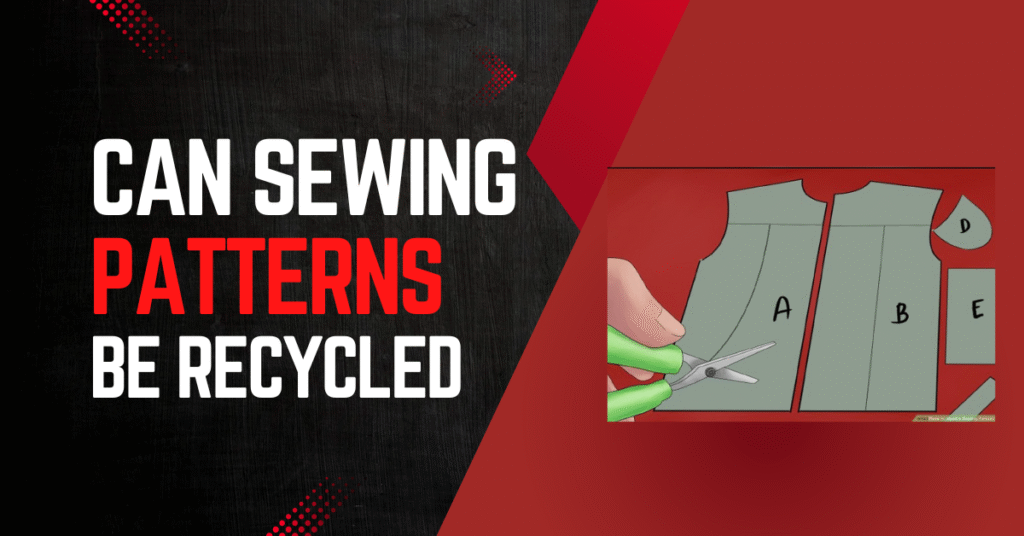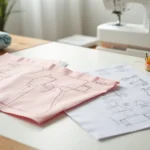Yes, if your sewing patterns printed on plain paper then it can be recycled. But if the patterns made with waxy, glossy, or coated tissue paper then it can’t be recycled. Check your local recycling guidelines to confirm. When recycling isn’t possible, consider reusing or donating patterns to sewing groups or craft organizations.
Can sewing patterns be recycled?
Most crafters wonder about the recyclability of their sewing pattern stash. The answer is both yes and no, depending on several factors.
Why most patterns aren’t accepted in standard recycling
Despite being paper-based products, sewing patterns face recycling challenges. Traditional tissue paper patterns—the thin, delicate sheets found in most commercial pattern envelopes—are technically recyclable. Nevertheless, many local recycling facilities reject them due to their unusual properties.
The primary issue is that most recycling centers have difficulty processing extremely thin papers. Furthermore, tissue papers have shorter fibers compared to regular paper, making them less valuable in the recycling stream. Consequently, even when placed in recycling bins, these patterns often end up in landfills.
Modern patterns printed on plasticized sheets present another problem altogether. These laminated or plastic-coated patterns cannot be processed through standard paper recycling. Before attempting to recycle any pattern, remember to remove all non-paper elements such as tape, pins, or metal fasteners.
Types of paper used in sewing patterns
Sewing patterns come in various materials, each with different recycling implications:
- Artist Tracing Paper: Commonly used for tracing patterns, this thin, transparent paper (about 50 cents per yard for a 36″ roll) tears easily when erased.
- Medical Exam Paper: Similar to tracing paper but narrower, requiring taping for larger pattern pieces (approximately 14 cents per yard).
- Dot Paper/Alphabet Paper: Stronger than tracing paper with good transparency, used in professional pattern making (costs about $1.20 per yard).
- Brown Craft Paper: Sturdy and opaque, excellent for frequently reused patterns.
- Bonded Textiles/Swedish Tracing Paper: Specialty material specifically for tracing patterns.
- Oak Tag: Thick material used for professional slopers that can withstand repeated tracing.
What makes recycling difficult
Beyond material considerations, several factors complicate pattern recycling. Tissue paper patterns often contain printing inks that may contaminate recycling batches. Additionally, patterns frequently include multiple paper types within one package—tissue for pattern pieces and cardstock for instructions.
Some crafters report that tissue paper cannot be recycled at all and suggest composting as an alternative. This contradictory information highlights the importance of checking your local recycling guidelines specifically regarding tissue paper acceptance.
The environmental impact extends beyond individual crafters. Major pattern companies reportedly discard unsold patterns in massive quantities rather than donating or discounting them. This industry-wide waste presents a significant sustainability challenge.
Creative ways to reuse old sewing patterns
Beyond recycling debates, there’s real joy in transforming old sewing patterns into new creations. These delicate treasures deserve a second life through creative reuse.
Make gift tags and greeting cards
Those tissue-thin pattern pieces make excellent materials for personalized cards and tags. To create fabric gift tags, simply cut pattern tissue into tag shapes, back them with cardstock for durability, and punch a hole for ribbon. Notably, vintage pattern envelopes can be reused “over and over” as eye-catching gift tags.
For greeting cards, try “fussy cutting” your favorite pattern elements and attaching them to blank cards using a sewing machine or adhesive. A zigzag stitch works particularly well for securing fabric to cardstock. The vintage illustrations found on pattern envelopes make charming focal points.
Create wall art or collages
Pattern envelopes offer “beautiful framed” display options. Fashion wall decor using vintage sewing patterns creates perfect artwork for sewing rooms or walk-in closets. For collages, try layering pattern tissue with dictionary pages, then adding stenciled designs for dimension. Mod Podge works wonderfully for adhering pattern pieces to canvas.
Use as wrapping paper or envelopes
Pattern tissue makes unique gift wrap with a crafty touch. Moreover, you can transform patterns into custom envelopes—simply open an existing envelope to use as a template, trace onto your pattern paper, cut, fold, and secure with double-sided tape.
Decorate storage boxes or folders
Essentially, pattern pieces add vintage charm to plain storage containers. Apply pattern illustrations to boxes using decoupage techniques for organizing sewing supplies.
Craft bookmarks or labels
Turn those narrow pattern scraps into practical bookmarks. Cut pattern tissue into bookmark shapes, apply to cardstock for stability, add a hole at the top, and thread ribbon through. For a vintage touch, incorporate bits from pattern envelopes, postage stamps, or postal cancelations.
Fortunately, finding old patterns is easy—thrift stores often sell them “for pennies”. Just ensure you’re not cutting up valuable vintage patterns that could be used by others!
Where to donate old sewing patterns
If you’ve decided your patterns have more life in them, donating is an excellent alternative to discarding. Several organizations welcome these valuable resources, giving them purpose beyond your sewing room.
Local thrift stores and community centers
Thrift stores typically have dedicated craft sections where patterns find new homes. Goodwill and Salvation Army accept pattern donations, often selling them for just 99 cents apiece. Similarly, community centers frequently welcome sewing supplies for their programs. According to experienced crafters, these donations provide valuable resources for people who cannot afford retail-priced patterns.
Some thrift stores specifically support charitable causes through pattern sales. For instance, in Athens, GA, Project Safe sells patterns with proceeds helping abused women and children. Meanwhile, local libraries sometimes maintain sewing sections where they accept pattern donations for community programs.
Sewing schools and educational programs
Educational institutions offer perfect homes for your old patterns. High schools with sewing classes, particularly those in low-income communities, greatly appreciate these donations. Likewise, many prisons now run sewing programs teaching inmates employable skills while boosting mental health.
Refugee support organizations like Sew For Hope use donated patterns in their training programs. Schools often incorporate sewing patterns into STEM projects and art classes.
Online sewing groups and forums
Social media provides excellent donation opportunities. Facebook groups, especially Buy/Sell/Trade communities, connect pattern donors with interested recipients. Platforms like Freecycle and Craigslist allow you to offer patterns locally without shipping concerns.
Creative reuse centers like SCRAP
Perhaps the most appropriate donation destinations are creative reuse centers. These community hubs collect discarded materials and resell them at bargain prices or donate them to teachers and organizations. SCRAP in San Francisco exemplifies this model, offering patterns alongside art supplies, fabric scraps, and other crafting materials.
These centers serve as “secondhand stores for traditional arts and crafts supplies” while keeping materials out of landfills. Beyond retail, they often host creative classes and workshops, further extending the life of donated items.
Can you sell or swap your patterns?
Your unused sewing patterns might be worth money! Beyond donating or recycling, selling or swapping offers another path for patterns that still have life in them.
Selling vintage patterns on Etsy or eBay
Vintage patterns often command surprising prices online. eBay has dedicated categories specifically for antique and collectible sewing patterns, showing the demand for these items. Etsy likewise hosts thousands of vintage pattern listings, with some sellers offering pattern bundles priced at over USD 100.
Old patterns can be particularly valuable when they feature unique designs or come from certain eras. Generally, vintage patterns from the 1930s through 1950s hold special appeal, as most have entered the public domain after their 28-year copyright period expired. Undoubtedly, patterns featuring unusual designs or rare styles tend to fetch higher prices.
Hosting or joining a pattern swap
Pattern swaps provide a practical alternative to selling. At organized swap events, participants bring patterns they no longer need and exchange them for others. During a typical swap, each person selects one pattern per “round” until everyone has had sufficient opportunities to choose.
To organize your own swap, secure a venue with ample table space, create category labels (cotton, knits, etc.), and establish clear rules about taking unclaimed items home. Participants should label their contributions with information about fabric type and yardage.
Tips for listing and pricing patterns
When pricing patterns for sale, research completed listings on eBay to gage current market rates. Most vintage patterns from the 1940s-50s typically sell for USD 12-25, though particularly desirable styles like wedding dresses or evening wear command premium prices.
Size is a significant factor—larger sizes (18-20) often sell better than very small ones. Subsequently, condition matters greatly; check that all pieces are present and undamaged.
For online listings, photograph both the envelope and contents clearly. Note any missing pieces honestly, as buyers appreciate transparency. Overall, pricing should reflect the pattern’s age, rarity, condition, and designer—with some sellers reporting rare patterns fetching hundreds of dollars.
Conclusion
Sewing patterns represent more than just crafting templates – they embody creativity, history, and potential. Throughout this exploration, we’ve discovered that while technically recyclable, most pattern materials face significant challenges in standard recycling streams. Therefore, reusing these precious resources offers a far better environmental choice than attempting to recycle them.
Creative repurposing stands out as the most rewarding option for old patterns. Gift tags, greeting cards, unique wall art, and custom wrapping paper all breathe new life into these delicate sheets. Additionally, storage solutions decorated with vintage pattern illustrations add charming touches to any crafting space.
Donating unwanted patterns creates another meaningful path. Thrift stores, educational programs, and creative reuse centers eagerly welcome these donations, ensuring your patterns continue inspiring others. Alternatively, selling vintage patterns might surprise you – what seems like outdated designs to you could become valuable treasures for collectors willing to pay premium prices.


